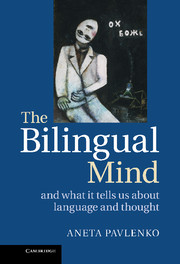Book contents
- Frontmatter
- Contents
- List of Tables
- Acknowledgments
- Preface
- 1 The Sapir-Whorf hypothesis and the bilingual turn in the study of language and cognition
- 2 Material worlds
- 3 Multidimensional worlds
- 4 Dynamic worlds
- 5 Narrative worlds
- 6 Discursive worlds
- 7 Emotional worlds
- 8 The bilingual mind and what it tells us about language and cognition
- References
- Author index
- Subject index
2 - Material worlds
Linguistic categorization of the ‘kaleidoscopic flux of impressions’
Published online by Cambridge University Press: 05 June 2014
- Frontmatter
- Contents
- List of Tables
- Acknowledgments
- Preface
- 1 The Sapir-Whorf hypothesis and the bilingual turn in the study of language and cognition
- 2 Material worlds
- 3 Multidimensional worlds
- 4 Dynamic worlds
- 5 Narrative worlds
- 6 Discursive worlds
- 7 Emotional worlds
- 8 The bilingual mind and what it tells us about language and cognition
- References
- Author index
- Subject index
Summary
We dissect nature along lines laid down by our native languages. The categories and types that we isolate from the world of phenomena we do not find there because they stare every observer in the face; on the contrary, the world is presented in a kaleidoscopic flux of impressions which has to be organized by our minds – and this means largely by the linguistic systems in our minds. We cut nature up, organize it into concepts, and ascribe significances as we do, largely because we are parties to an agreement to organize it in this way – an agreement that holds throughout our speech community and is codified in the patterns of our language. The agreement is, of course, an implicit and unstated one, BUT ITS TERMS ARE ABSOLUTELY OBLIGATORY; we cannot talk at all except by subscribing to the organization and classification of data which the agreement decrees.
Whorf, 1940, in 1956: 213–214What do we see when we see the world around us? Given that our vision relies on the same neurobiological mechanisms, be it in Aboriginal Australia or in Western Europe, surely we all see the same thing? Maybe and maybe not. Research shows that, in the process of adaptation to the environment, our perception undergoes long-lasting changes that enhance our ability to process and respond to environmental stimuli (Goldstone, 1998; Seger & Miller, 2010). In this chapter, we will consider the effects of this perceptual learning in the domain of greatest interest to Whorf, namely categorical perception. Grounded in basic cognitive abilities, such as memory and pattern recognition, categorical perception enables us to organize the ‘kaleidoscopic flux of impressions’ via rapid discrimination between stimuli, identification of individual stimuli as members of larger categories of objects, properties, relations, and phenomena, and activation of a large amount of information about these categories that, inter alia, allows us to judge typicality of individual members and instances (Brosch et al., 2010; Harnad, 1987; Rosch, 1977, 1978).
- Type
- Chapter
- Information
- The Bilingual MindAnd What it Tells Us about Language and Thought, pp. 40 - 83Publisher: Cambridge University PressPrint publication year: 2014

